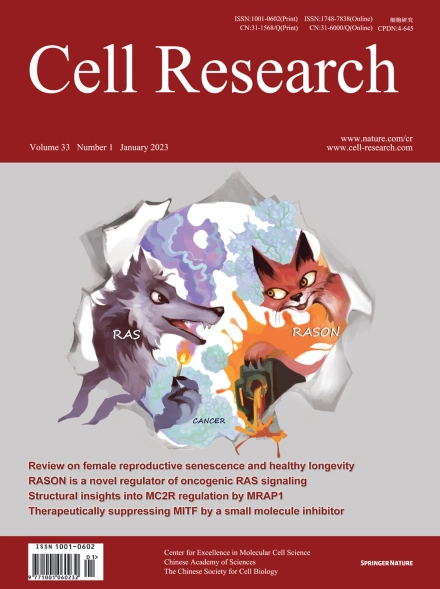
Advanced Search
Submit Manuscript
Advanced Search
Submit Manuscript
Volume 33, No 1, Jan 2023
ISSN: 1001-0602
EISSN: 1748-7838 2018
impact factor 17.848*
(Clarivate Analytics, 2019)
Volume 33 Issue 1, January 2023: 46-54
Structural basis of signaling regulation of the human melanocortin-2 receptor by MRAP1
Ping Luo1,† , Wenbo Feng2,† , Shanshan Ma1 , Antao Dai3 , Kai Wu1 , Xianyue Chen4 , Qingning Yuan1 , Xiaoqing Cai3 , Dehua Yang3,4,5 , Ming-Wei Wang2,3,4,5,* , H. Eric Xu1,5,6,7,* , Yi Jiang6,8,*
1The CAS Key Laboratory of Receptor Research, Shanghai Institute of Materia Medica, Chinese Academy of Sciences, Shanghai, ChinaG protein-coupled receptors (GPCRs) are regulated by various downstream proteins, of which the melanocortin receptor accessory protein 1 (MRAP1) is closely involved in the regulation of melanocortin receptor 2 (MC2R). Assisted by MRAP1, MC2R responds to adrenocorticotropic hormone (ACTH) and stimulates glucocorticoid biogenesis and cortisol secretion. MC2R activation plays an essential role in the hypothalamic-pituitary-adrenal (HPA) axis that regulates stress response, while its dysfunction causes glucocorticoid insufficiency- or cortisol excess-associated disorders. Here, we present a cryo-electron microscopy (cryo-EM) structure of the ACTH-bound MC2R–Gs–MRAP1 complex. Our structure, together with mutagenesis analysis, reveals a unique sharp kink at the extracellular region of MRAP1 and the ‘seat-belt’ effect of MRAP1 on stabilizing ACTH binding and MC2R activation. Mechanisms of ACTH recognition by MC2R and receptor activation are also demonstrated. These findings deepen our understanding of GPCR regulation by accessory proteins and provide valuable insights into the ab initio design of therapeutic agents targeting MC2R.
https://doi.org/10.1038/s41422-022-00751-6